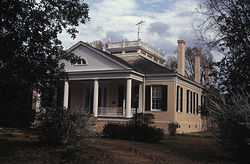Lansdowne (Natchez, Mississippi)
|
Lansdowne | |
 | |
| Location | Pine Ridge Road, Natchez, Mississippi |
|---|---|
| Area | 20.5 acres (8.3 ha) |
| Built | 1853 |
| Architectural style | Greek Revival |
| Governing body | Private |
| NRHP Reference # | 78001581[1] |
| Added to NRHP | July 24, 1978 |
Lansdowne is a historic mansion in Natchez, Adams County, Mississippi.
Location
It is located on Pine Ridge Road, one mile north of the Natchez city limits.[2]
History
David Hunt (1779-1861), a prominent plantation owner in the Antebellum South, gave his daughter Charlotte Hunt and his new son-in-law, George M. Marshall, Lansdowne Plantation as a dowry, and the couple planned and built the mansion on the plantation in 1852-53.[3][4][5][6] Before the American Civil War of 1861-1865, the plantation was 800 acres in size with cotton as its cash crop.[7] Not being one of David Hunt's biggest plantations, he gave Charlotte another plantation across the Mississippi River in Louisiana as well.[8] A portrait of Levin R. Marshall and George M. Marshall, painted by Louis Joseph Bahin, hangs in the dining-room.[9]
George Marshall had twenty-two slaves on Lansdowne and owned Louisiana real estate valued at $119,000.[10] His father was Levin R. Marshall, a Natchez millionaire planter who owned 1,058 slaves just before the Civil War.[11]
George Marshall fought in the Civil War.[7] He was wounded at the Battle of Shiloh, returned home, and paid someone else to fight on in his place.[7] During the War on December 12, 1865, eleven Union soldiers broke into Lansdowne to rob the Marshalls.[7] They did not get much because the butler, Robert, had hidden the Marshall's silver under the floor of the mansion.[7] In frustration the soldiers took a few pieces of the Marshall's fine china and smashed it along the road as they left.[7]
The mansion and 120 acres still belong to the Marshall descendants.[4] It has been added to the National Register of Historic Places since July 24, 1978.
Architecture
The mansion was designed in the Georgian Revival architectural style.[5] The exterior of the mansion is deceiving, given the scale of the rooms within.[12] It has high ceilings, and a 65 foot long center hall.[2] The great size of the hall gives it a more extravagant feel than is found in many of the larger Natchez mansions.[6] To the right of the hall are three bedrooms.[12] To the left of the hall are the drawing room, dining room and butler's pantry.[2][12] Due to the impending Civil War, the Marshalls finished the mansion quickly, leaving off the planned second floor.[8] The mansion is important because it contains most of its original interiors and furnishings.[2] The home contains Zuber & Cie wallpaper, rosewood and mahogany furniture, and Egyptian marble mantelpieces.[3] Two dependency structures flank the rear courtyard behind the house.[2] During antebellum times, they housed the kitchen, wash room, servant's rooms, billard room, office, schoolroom and governess's room.[2]
Outside, the grounds span 140 acres, including Spanish moss, streams, woodland.[3]
References
- ↑ "National Register Information System". National Register of Historic Places. National Park Service. 2010-07-09.
- ↑ 2.0 2.1 2.2 2.3 2.4 2.5 Lansdowne, Spring Pilgrimage 2013 - a special publication of The Natchez Democtat, North Canal Street, Natchez, MS
- ↑ 3.0 3.1 3.2 Caroline Seebohm, Enshrining the Old South, The New York Times, February 10, 1991
- ↑ 4.0 4.1 Official website: History
- ↑ 5.0 5.1 Helen Kerr Kempe, The Pelican Guide to Old Homes of Mississippi: Natchez and the South, Gretna, Louisiana: Pelican Publishing, 1989, p. 52
- ↑ 6.0 6.1 Van Court, Catherine (1937). In Old Natchez. Doubleday. pp. 53–55.
- ↑ 7.0 7.1 7.2 7.3 7.4 7.5 Caroline Seebohm and Peter Woloszynski, Under Live Oaks, Clarkson Potter: New York, 2002, pp 144 - 157
- ↑ 8.0 8.1 Kane, Harnett T. Natchez on the Mississippi (1947 ed.). New York: Bonanza Books. pp. 180 – 181.
- ↑ Official website: Tour
- ↑ Jordan, Winthrop D. (1995). Tumult and Silence at Second Creek. LSU Press. p. 125.
- ↑ Scarborough, William (2006). Masters of the Big House. LSU Press. p. 15.
- ↑ 12.0 12.1 12.2 Howard, Hugh (2003). Natchez: the Houses and History of the Jewel of the Mississippi. New York: Rizzoli. pp. 137 – 141.
| ||||||||||||||||||||||||||